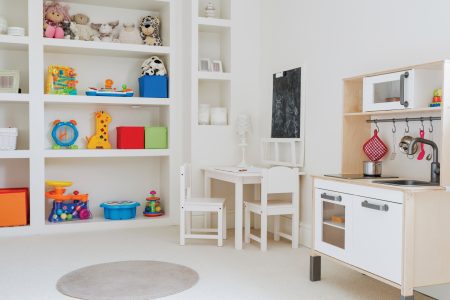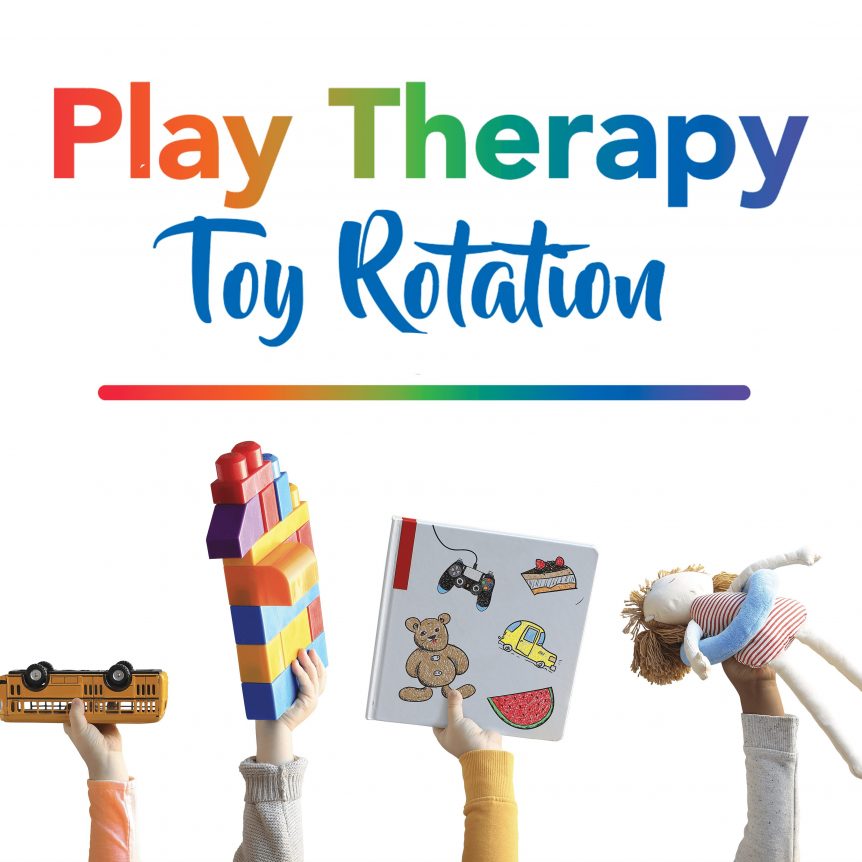Written by Anna Claire Pritchard, MOT, LOTR
Happy new year! This year I plan on introducing important skills needed for daily function in each issue as well as toys that can promote each skill within your home. But first, before I bombard you with fun new toys, I thought we should talk toy cleanout and the art of toy rotation. I know after the holidays our homes are filled with new toys and our play spaces tend to become overwhelmed with the combination of the new and the old.
No two toy rooms or toy “spaces” are just alike. That is the beauty of toy rotation – it can be applied no matter what your space looks like. Some people have designated toy rooms or maybe yours is a small (or large) section of your living room. Maybe all your child’s toys are kept in their room. Whatever the scenario, these simple suggestions can be applied to your home and space.
When toy spaces become overcrowded our children tend to become overwhelmed. This is true no matter the size of your space. The more toys that are out and available for your child the less likely they are to engage in meaningful play with them. How many times have you seen your child reach into the toy basket and grab the toy on the top of the stack, then the next, then the next . . . you get where I am going with this? Before you know it, they have pulled every toy out of the basket, but they haven’t really sat down to engage in purposeful play with any of the toys. You look up and every toy you own is on the floor and you are singing the cleanup song one too many times in order to get the space back in order.
So, before we get started on the art of toy rotation, we need to do a little purging. I am hopeful these tips will help to clean up your toy space and better engage your child in meaningful play with his or her toys.

What can go permanently?
This is hard for me. I love to keep things – just ask my husband. I have a really hard time throwing things away, especially if they have any memories attached to them. BUT, as I am sure you know, there are tons of toys out there that serve the same purpose, especially for younger children.
First step is to see what can be tossed: look for items that are broken, worn out, or have too many missing pieces to work properly.
Next, group together toys that serve the same purpose and determine:
Which is more appealing to your child?
If you have two toys that are very similar, but your child always plays with one over the other – it’s time to toss the one that is not touched and hold onto the one that is played with more often.
Which toy is more durable?
Is one toy made better than the other? Maybe one is plastic and the other wood. Can the toy be used in more than one way? Go with the ones that will last the longest and can be used the most.
What to do with toys that go?
- Make a small toy basket to keep at friend’s or family’s house that you visit often
- Donate to a family in need
- Donate to your child’s daycare or school
HOW DO I ROTATE TOYS?
Now that you have decided what can stay and what can go permanently, it is time for the next step. How to decide on what toys can stay and what toys can be stored temporarily. This is where there is a lot of flexibility, so do not be nervous. Toy rotation is simply a way to clean out your toy space to allow for greater purposeful play.
It is time to sort through toys one last time. Find toys that you have decided to keep permanently and group them together based on similarities.
For example:
Early Childhood: rattles, sorting, stacking, sensory play, puzzles
Elementary School: arts and crafts, games, dolls, pretend play items (kitchen sets)
Middle School: books, arts and crafts, STEM kits, Legos
Once you have grouped together like items, choose one or two items from each group to leave out. If you have more than one child, this is where the flexibility comes into play – do what is best for your household. You may have more toys out depending on the number of children you have as well as their ages. I really encourage you to work on downsizing during this phase – I know it is hard to believe that having so few toys out will keep your child’s attention but trust me you will see greater engagement and imagination come to life. If you start to run out of storage space, feel free to keep more toys out. Do what works best for your home.
OK, now you know what toys are staying and going, it is time to store the remaining toys. When considering storing, find a place in your home that is easily accessible to you – a hall closet, under beds, unused storage in your child’s closet. Whatever works best for you! You want this to be a place that is easily accessible for you or you will begin to dread this process. To be honest the toys we are currently rotating in our household are in a container in our dining room – not the most ideal place but it is easily accessible and works for us.
You have chosen a spot that is easily accessible to you, now how do you store? I LOVE clear Rubbermaid containers. I can easily see what is inside each box and they are the perfect size for larger items. Go back to where you are storing items and see what will work best for you and that space. It may be that you need bins with wheels for under bed storage or more flexible containers like large zip-lock storage bags. Again, there is no right or wrong to this process – it is whatever works for you and your space.
I recommended storing items as you have grouped them initially when you began this process (rattles, sorting, stacking, etc.). This will make the rotating aspect much easier. When it comes time to rotate toys, you will grab a few items from each category and replace them with the items you already had out. It will become an easy and natural process the more you do it. Which brings us to our next most frequently asked question. How often do you rotate toys? Let your child or children lead on this decision. If you see they are becoming bored with the items that are currently out or spend less and less time each day with their toys, it is probably time to rotate. This can be anywhere from a week or a few weeks, depending on your child’s current likes and interests and their age.
The toys that you have decided to keep out can be displayed within your toy space. Shelves are a great option for housing toys – they are easily accessible to little ones and it is easy to see what is available for play. Ikea and Target make great shelving options for toy spaces. If you do not like the look of shelves or prefer for toys to be more hidden within the space, baskets or bins are great options. No need to buy anything new for this step – you can make what you currently have work. The key is to keep toys easily accessible to your little ones.
During each rotation leave out one or two items that are most frequently played with and rotate the rest. Items like slides, small trampolines, and kitchen sets are toys that can stay out during each rotation. Just rotate out the foods that are housed in the kitchen – so leave out just the pizza set, there is no need to have every item found in the grocery store out at all times.
You have purged, sorted, stored, and displayed, and now you are on your way to allowing for optimal play time no matter your play space.
Anna Claire is a pediatric occupational therapist at Building Futures Pediatric Therapy Center. Her love of occupational therapy began at a young age. She incorporates fun, creative facets as well as holistic approaches to better assist her clients in reaching their goals. She has experience in a variety of settings from a multidisciplinary center for children with Autism and communication disorders to home health and an outpatient clinic for children and adults with a wide variety of diagnoses such as traumatic brain injury, CVA, cerebral palsy, Sensory Processing Disorder and dysgraphia. Her diverse population of patients is one of her favorite aspects of occupational therapy. Due to her innate love for children, she chose Pediatric occupational therapy as her focus. Anna Claire cares for all of her patients on a personal and professional level.

